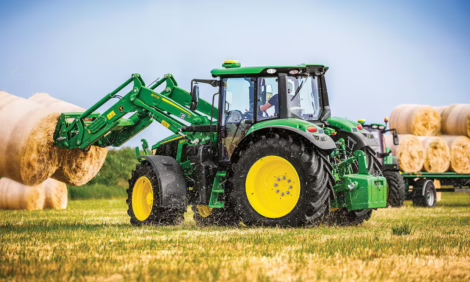



Brazil's Soybean, Corn Feed Prices Head Higher
ANALYSIS - Informa Economics FNP said severe weather and crop failures in south Brazil and increased consumption demand are driving up corn (maize) and soybean meal costs, putting pig and poultry farmers on alert, writes Sarah Mikesell, senior editor.Ariovaldo Zani, executive VP of Brazil’s National Animal Feed Industry Association, Sindirações, said feed production this year will increase by 3.0 to 3.5 per cent. Feed costs account for about 60 per cent of Brazilian pig and poultry producers’ total production cost.
“The Brazilian animal feed industry depends on the food industry which, in turn, is modulated by domestic and international consumer demand,“ Brazil’s National Animal Feed Industry Association said in a statement.
Soybean meal and corn account for about 80 per cent of the feed consumed by poultry and pigs in Brazil.
According to the Association, last year, 66 million tons of feed were produced, with 37.8 million tons going to poultry farms and 15.4 million tons going to pig farms. On poultry farms, 61 per cent of the feed is made up of corn and 25 per cent soybean meal, while pig feed is made up of 68 per cent corn and 16 per cent is soybean meal.
Brazil’s Corn, Soybean Markets
Informa Economics FNP believes the area planted with summer corn and soybeans for 2011/12 was up by 5.3 per cent year on year but because of the serious drought in south Brazil, production will be down about eight per cent versus the previous season. The US Department of Agriculture (USDA) has estimated an 11 per cent soybean production reduction in southern Brazil due in large part to the La Niñ weather phenomenon.

For corn, the average productivity in the southern region will be much lower than last season and even less than the average of the last 10 years which will increase the dependence on the winter corn crop, said Aedson Pereira, Information Economics FNP analyst.
Winter corn areas are expected to increase but it is too early to predict if that will equate into larger production. Zani expects winter corn can make up the difference and anticipates no issues.
Brazil’s summer production will be 36 million tons in the 2011/2012 harvest, which is up 0.2 per cent over year ago, said Informa Economics FNP. This slight bump in production was the result of other regions of Brazil significantly increasing production levels.
“The numbers give the impression that competition for corn will be strong this year,“ said Pereira. “The most optimistic scenario at Informa Economics FNP indicated production of 298 million tons on an area of 6.8 million hectares.“
Growth Opportunity
Expansion of soybean area in the Center–West and Northeast regions has been occurring at a very fast pace on the heels of high commodity prices and mainly through land lease contracts of abandoned farms and/or degraded pasture–lands, says the USDA GAIN report.
Possessing 20 per cent of the planet’s fresh water, Brazil also has tremendous potential to expand planted area via irrigation projects that make possible second and third crops rotated over a yearly growing season. Recent historically high crop prices have greatly improved the time–frame for return on investment with the main constraints being water use licences and capital investment requirements.
Large irrigation project investments are increasing soybean planted area and are made possible through rotating cash crop production – wheat, edible bean, cotton – based on the market’s current highest returns.
Exports Down; Recovery Expected in 2012/2013
Soybean exports in marketing year 2011/12 are estimated at 29mmt, down 14 per cent from the 2010/11 record of 33.8mmt. Over the last few months, current high prices and favorable exchange rate have directed Brazilian soybeans to the export market as opposed to the domestic crush market, according to USDA.
However, USDA expects the market to turn inward to supply crush in the second semester of 2012 as a return to traditional export windows to third markets based on price competitiveness at harvest between the US and Brazil occurs. Also, export logistics and port capacities will be strained the second half of 2011 as soybeans compete with sugar, corn, and other export crops.
These expectations together with a drought-reduced short crop will reduce Brazil’s export market share in 2011/12. That said, USDA forecasts a recovery in Brazil’s export market presence in 2012/13 reaching a new record of 35mmt based on continued strong global demand.

International Market
Competition between the domestic and international markets will be aggressive come mid-September when the US harvest is underway. Two years in a row of moderate to poor production have limited the global corn and soybean supply.
La Niñ has also had a significant impact on the Argentina corn and soybean harvests in 2011 and 2012. Despite being the third largest global soybean exporter, Argentina’s international market share slipped the last few years, contributing to the increase in international commodity prices.
Argentina’s soybean production is also slipping. In 2009/2010, it was reported at 54.5 million tons but FNP expects it to only reach 45 million tons in the current season. Corn is following a similar course, falling from 23.3 million tons harvested in 2010 to 20.5 million tons this season. Argentina’s corn exports have also seen a dip from 16.5 million tons in 2010 to 13.5 million this year.
US production was also down last year, due mostly to an exceptional wet spring in the eastern half of the Midwest followed by extreme summer heat during the critical tasseling period. This year could be brighter though, as weather has cooperated so far and US growers have been able to get crops in the ground earlier than usual.
China continues to support the demand side with major purchases of soybeans and has resumed its corn imports due to a decrease in local production. China remains the largest world consumer of corn, feeding huge numbers of poultry and pigs.
According to Informa Economics FNP, Brazilian agribusiness has increased sales to China buy three per cent while Brazil‘s export revenue to China has increase by 17.5 per cent.








